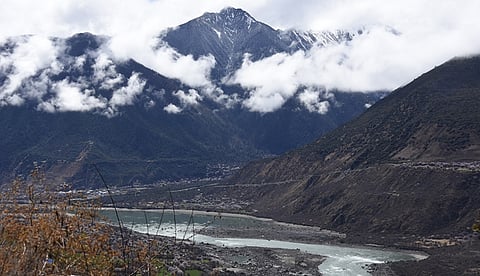There are big companies in China lobbying to build dams: Claude Arpi
Speculation has been rife in India ever since China’s state-run Xinhua news agency reported that the Chinese government on December 25, 2024, had approved the construction of the world's largest hydropower dam on the ‘Great Bend’ of the Yarlung Tsangpo, known as the Siang and Brahmaputra in India’s Northeast.
The Brahmaputra is the lifeline of the Northeast. A huge dam on the mighty river could make it dry, while also raising the risk of floods during the wet season. The construction of the dam in a highly seismically active zone raises even more fears.
Well-known French-born Tibetologist, Claude Arpi is the author of several books on the links between India and Tibet. Down To Earth spoke to Arpi about the implications of a dam on the Brahmaputra in a week when a M7.1 earthquake struck Tingri county in Tibet, north of Nepal.
Edited excerpts:
Rajat Ghai (RG): Tibet is very highly prone to climate change and is also a seismically active zone. Do you think all this will be exacerbated by China’s very flawed policies in the region including building the world’s largest dam according to recent reports?
Claude Arpi (CA): I am not very sure as to whether China intends to build a big dam on the Brahmaputra as Tibet is seismically active. It may build a series of hydel power projects instead.
On August 15, 1950, the Assam-Tibet Earthquake of M8.7 took place in what is today’s Arunachal Pradesh’s Lohit and Anjaw districts. The 14th Dalai Lama of Tibet was 15 at the time. In his memoirs, he notes, “It was like an artillery barrage – which is what we assumed to be the cause of both the tremors and the noise: a test of some sorts being carried out by the Tibetan army… Some people reported seeing a strange red glow in the skies in the direction from which the noise came….”
The 1950 quake happened not very far from Upper Siang. The seismicity is the same across the entire region. If you consider the fact that the latest earthquake (on January 7, 2025) has occurred in Tingri, which is on the plateau above Nepal, building a dam in Upper Siang or Lohit or Subansiri is being far more adventurous. And this is true for dam-building on both sides of the border. There is no certainty that an earthquake will never strike in such an area.
I hope China proceeds with caution in this matter. But the issue in China is that there are big companies lobbying to build dams.
Years ago, I had met people from the Chinese Academy of Sciences. They were of the view that China should not build dams. Scientifically, they know the costs of such a venture. When Wen Jiabao was the Chinese premier, he put an embargo on dams as good sense prevailed.
However, the aforementioned lobbies are still there. The People’s Liberation Army (PLA) itself lobbies to construct dams. Dams mean a lot of money. Who do you think prevails in that case? Scientific thinking and common sense, or the power and money lobby?
This is true not just for China but almost every place in the world.
RG: What has been the effect of infrastructure activities on the socio-cultural lives of Tibetans within the Tibetan Autonomous Region of the PRC?
CA: Ethnic Tibetans have no say in these infrastructure projects because mostly such projects are with the PLA and most are dual use. So, they will be used by the civilian administration too in addition to the military. However, the Chinese Communist Party (CCP)’s secretary in Tibet since 1951-52 has always been an ethnic Han.
I can also tell you that if tomorrow, the Dalai Lama gets the genuine autonomy that he is asking for, this infrastructure will still remain with the central government and the CCP will not come to the local Tibetan people. Tibetans are thus only witness to all that is happening. Maybe they also get a bit of revenue. But they have no say in the decision-making.
RG: Tibet is the water tower of Asia. What future do you see for the Tibetan Plateau given the rapid pace of climate change and infrastructure development?
CA: The Yarlung Tsangpo, which becomes the Siang and the Brahmaputra, has not been affected too much till now. However, other rivers flowing out of Tibet such as the Mekong, the Yangtze and the Salween have been extensively dammed. The effects have been felt in Southeast Asia — in Laos, Vietnam and Cambodia.
Thus, whatever happens in Tibet, its effects will be felt not just on the plateau but also on countries downstream. The issue is that China neither has nor wants to sign any agreements with lower riparian countries.
I hope common sense prevails but that will not be the case because powerful lobbies are at work.


